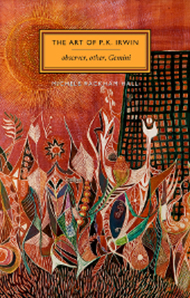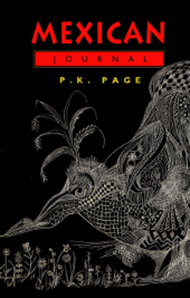Reviews
Nonfiction Reviews by John Reibetanz
Michèle Rackham Hall, The Art of P. K. Irwin: observer, other, Gemini (Erin, Ontario: The Porcupine’s Quill, 2016). Paperbound, 144 pp., $22.95.
P. K. Page, Mexican Journal ed. Margaret Steffler (Erin, Ontario: The Porcupine's Quill, 2015). Paperbound, 288 pp., $27.95.
 In “A Basket of Chestnuts,” Seamus Heaney conjures up the chestnuts in “this basket” and wishes “they could be painted, known for what / Pigment might see beyond them, what the reach / Of sense despairs of as it fails to reach it, / Especially the thwarted sense of touch.” This little tribute by a poet to the art of the painter acknowledges that pigment may be charged with vatic power: it can carry us beyond the realm of the senses and (since stale or often-repeated words are “chestnuts,” and a poem might wryly be seen as a basket of them) beyond the scope of words.
In “A Basket of Chestnuts,” Seamus Heaney conjures up the chestnuts in “this basket” and wishes “they could be painted, known for what / Pigment might see beyond them, what the reach / Of sense despairs of as it fails to reach it, / Especially the thwarted sense of touch.” This little tribute by a poet to the art of the painter acknowledges that pigment may be charged with vatic power: it can carry us beyond the realm of the senses and (since stale or often-repeated words are “chestnuts,” and a poem might wryly be seen as a basket of them) beyond the scope of words.
Two fine books from The Porcupine’s Quill, both lavishly illustrated with superb reproductions of P. K. Page’s art, explore her more protracted arrival at this recognition. Michèle Rackham Hall’s The Art of P. K. Irwin (“Irwin” being Page’s married surname and nom de brosse) follows the evolution of her visual art from the 1950s onwards, while Margaret Steffler’s edition of Page’s Mexican Journal documents the years (1960-63) when that art was most crucial to her personal and creative well-being. As Rackham Hall asserts, although “the artist in Page was alive” many years before “P. K. Page the poet became P. K. Irwin the painter” during her stay in Brazil from 1957 to 1959, it was in Mexico she experienced her darkest hours and where painting provided desperately needed luminosity (both material and symbolic) to open ways back into poetry.
 The Journal opens dramatically: “Black, black, black is the colour of a Mexican night,” and it soon becomes evident that the darkness is as much internal as external. Yes, the culture has its share of poverty, violence, and dark gods, but Page’s repeated observation that “the sunlight here is grey” contrasts markedly with Sybille Bedford’s impression in The Sudden View, a 1953 travel memoir, which Page had read. Bedford wrote that in Mexico City, “gray days are unknown . . . the sky is always clear.” The darkness that at times overwhelms Page results in part from the demands that being the Canadian ambassador’s wife made on her peace of mind and energy: “All the calls, all the Canadians, all the parties—leave one rather like a negative print of oneself.” In addition, the hysterectomy she had undergone (and about which she was characteristically reticent and private, although the matter surfaces symbolically in many paintings of womb or egg shapes) left her feeling empty and unfulfilled: in a rare unguarded moment in 1961, she writes “childless women I think must feel very terminal. I know I do.”
The Journal opens dramatically: “Black, black, black is the colour of a Mexican night,” and it soon becomes evident that the darkness is as much internal as external. Yes, the culture has its share of poverty, violence, and dark gods, but Page’s repeated observation that “the sunlight here is grey” contrasts markedly with Sybille Bedford’s impression in The Sudden View, a 1953 travel memoir, which Page had read. Bedford wrote that in Mexico City, “gray days are unknown . . . the sky is always clear.” The darkness that at times overwhelms Page results in part from the demands that being the Canadian ambassador’s wife made on her peace of mind and energy: “All the calls, all the Canadians, all the parties—leave one rather like a negative print of oneself.” In addition, the hysterectomy she had undergone (and about which she was characteristically reticent and private, although the matter surfaces symbolically in many paintings of womb or egg shapes) left her feeling empty and unfulfilled: in a rare unguarded moment in 1961, she writes “childless women I think must feel very terminal. I know I do.”
So, just as she had responded to linguistic isolation in Brazil by turning from words to painted images, in Mexico Page confronts darkness with the lights of pigment. She presses Leonora Carrington to teach her how to use the “sublimely luminous” egg tempera, opening her palette to the bright reds, yellows, greens, and blues of local weaving and flowers. Most especially, she learns how to work with gold leaf: “I got so excited by it that I couldn’t stop and now have far too large an area on my panel covered with gold.” As Steffler astutely observes, the “vibrant, ongoing and transformative” nature of what Page called “flying gold” contrasts with “the purely sensuous gold that enveloped Brazil, ‘golden, perfect, complete.’” Comedy has given way to tragicomedy.
Page writes in the Journal that, in all creative expression, “the language itself has to be invented first; and each thing to be said needs its own language.” In Mexico, the language of painting leads her back to the language of poetry. Not only does poetry resume its primary place in her creative output when she returns to Canada, as Rackham Hall notes, but as if in response to the rich, complex visual imagery of her paintings, the poetry that she writes after her Mexican experience is quickened by more concentrated and dynamic verbal imagery. As an example, one might compare some lines from the 1950s “Arras” (which provides Rackham Hall with her subtitle) with some from Hologram’s “The Gold Sun.” “Arras” elaborates a single image: “I ask, what did they deal me in this pack? / The cards, all suits, are royal when I look. / My fingers slipping on a monarch’s face / twitch and grow slack. / I want a hand to clutch, a heart to crack.” In contrast, the images of “The Gold Sun” won’t stand still, and keep generating further images: “Sky whitened by a snow on which no swan / is visible, and no least feather falling / could possibly or impossibly be seen, / sky whitened like the blank page of a book, / no letters forming into words unless / written in paleness – a pallidity / faint as the little rising moons on nails.”
Along with its more protean imagery, the art that Page created in Mexico brought a more heightened objectivity, something long sought by her. In a passage from her unpublished Brazil journals, quoted by Rackham Hall, she writes, “I may have changed from writing to painting because one is freer to uncover oneself without in the same way being exposed,” and, in a later essay, she praises Islamic art because it is “beautiful without showing the marks of a subjective individualistic inspiration. Its beauty must be impersonal like that of a starry sky.” This aesthetic preference stayed with Page, and it might be argued it reached its fullest poetic expression in the glosas and rengas she wrote in the 1990s, the shared medium of each of these forms lifting her out of more exclusively “individualistic inspiration” while providing a conceptual vocabulary for the themes attached to the spiritual journey she began in Mexico. There, she learned how to respond to darkness with painterly light, and to an incoherent void with affirmative words. As she was later to write in “Traveller, Conjuror, Journeyman,” “in all essential particulars writing and painting are interchangeable. They are alternate roads to silence.”
—John Reibetanz









